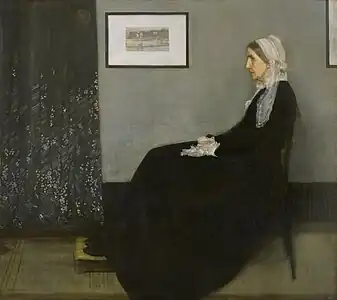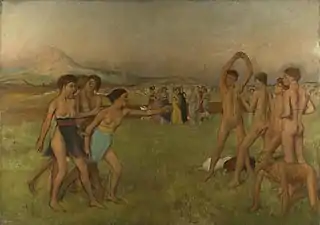Figure painting
A figure painting is a work of fine art in any of the painting media with the primary subject being the human figure, whether clothed or nude. Figure painting may also refer to the activity of creating such a work. The human figure has been one of the constant subjects of art since the first stone age cave paintings, and has been reinterpreted in various styles throughout history.

Unlike figure drawings which are usually nudes, figure paintings are often clothed depictions which may be either historically accurate or symbolic. Figure painting is not synonymous with figurative art, which may depict real objects of any kind (including humans and animals).
Clothed figures
Portraiture
A portrait painting focuses on the creation of a likeness of a particular individual or group.[1]
Everyday life
Genre painting portray ordinary people engaged in common activities.
Narrative paintings
Historical paintings depict events in a narrative, which may be allegorical.
Nude figures
The nude has been a theme in Western art since classical antiquity[2] and again in Renaissance art, after being largely absent during the Middle Ages.[3] While standing nude figures of both sexes are found in antiquity, in Western art, male nudes were more prevalent through the idealisation of the male form in society. The first female reclining nudes as a popular genre appeared during the Renaissance, most notably in a work by Giorgione.[4] Oil paint historically has been the ideal media for depicting the figure. By blending and layering paint, the surface can become more like skin. "Its slow drying time and various degrees of viscosity enable the artist to achieve rich and subtle blends of color and texture, which can suggest transformations from one human substance to another."[5] Although working from live models is preferred, the length of time needed to complete a painting has led most modern painters to use photographs as references at least part of the time if not for the entire work.
History and styles
 Thebes c. 1400 BCE
Thebes c. 1400 BCE 5th-century mural painting from the Ajanta Caves, India
5th-century mural painting from the Ajanta Caves, India Winged genius, fragment. Second-style mural painting, Roman artwork, late 1st century BCE.
Winged genius, fragment. Second-style mural painting, Roman artwork, late 1st century BCE.
 Reclining Nymph by Lucas Cranach the Elder
Reclining Nymph by Lucas Cranach the Elder_2.jpg.webp) Adam and Eve (1507) by Albrecht Dürer
Adam and Eve (1507) by Albrecht Dürer Venus and the Lute Player (1565–1570) by Titian
Venus and the Lute Player (1565–1570) by Titian

 Olympia (1863) by Édouard Manet
Olympia (1863) by Édouard Manet
 Young Spartans Exercising, c. 1860 by Edgar Degas
Young Spartans Exercising, c. 1860 by Edgar Degas
_-_The_Wave_(1896).jpg.webp) The Wave (1896) by William-Adolphe Bouguereau
The Wave (1896) by William-Adolphe Bouguereau Winged Figure (1889) by Abbot Handerson Thayer
Winged Figure (1889) by Abbot Handerson Thayer
 Nude Descending a Staircase, No. 2 (1912) by Marcel Duchamp. Oil on canvas. Philadelphia Museum of Art.
Nude Descending a Staircase, No. 2 (1912) by Marcel Duchamp. Oil on canvas. Philadelphia Museum of Art. Sitzender weiblicher Akt mit aufgestützen Ellbogen (1914) by Egon Schiele
Sitzender weiblicher Akt mit aufgestützen Ellbogen (1914) by Egon Schiele Red Nude (1917) by Amedeo Modigliani
Red Nude (1917) by Amedeo Modigliani
Notes
- Brilliant, Richard (1987). "Editors Statement: Portraits: The Limitations of Likeness". Art Journal. 46 (3): 171–172. doi:10.1080/00043249.1987.10792358.
- Sorabella, Jean (January 2008). "The Nude in Western Art and its Beginnings in Antiquity, In Heilbrunn Timeline of Art History". New York: The Metropolitan Museum of Art. Retrieved 25 October 2012.
- Sorabella, Jean (January 2008). "The Nude in the Middle Ages and the Renaissance, In Heilbrunn Timeline of Art History". New York: The Metropolitan Museum of Art. Retrieved 25 October 2012.
- Ferrara, Lidia Guibert (2002). Reclining Nude. London: Thames & Hudson. pp. 6, 7. ISBN 0-500-23797-2.
- Scala, p. 1
See also
References
Books
- Clark, Kenneth (1956). The Nude: A Study in Ideal Form. Princeton: Princeton University Press. ISBN 0691017883.
- Hughes, Robert (1997). Lucian Freud Paintings. Thames & Hudson. ISBN 0500275351.
- Rosenblum, Robert (2003). John Currin. Harry N. Abrams. ISBN 0810991888.
- Scala, Mark, ed. (2009). Paint Made Flesh. Vanderbilt University Press. ISBN 978-0826516220.
- Steiner, Wendy (2001). Venus in Exile: The Rejection of Beauty in Twentieth-century Art. The Free Press. ISBN 0684857812.
Web
- Ryder, Edmund C (January 2008). "Nudity and Classical Themes in Byzantine Art, In Heilbrunn Timeline of Art History". New York: The Metropolitan Museum of Art. Retrieved 25 October 2012.